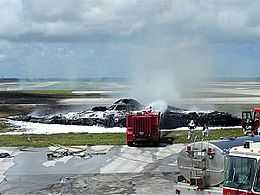2008 Andersen Air Force Base B-2 accident
|
The crashed Spirit of Kansas | |
| Accident summary | |
|---|---|
| Date | 23 February 2008 |
| Summary | Stall, loss of control |
| Site |
Andersen Air Force Base, Guam 13°35′7.14″N 144°56′12.43″E / 13.5853167°N 144.9367861°ECoordinates: 13°35′7.14″N 144°56′12.43″E / 13.5853167°N 144.9367861°E |
| Crew | 2 |
| Survivors | 2 |
| Aircraft type | B-2 Spirit |
| Aircraft name | Spirit of Kansas |
| Operator | United States Air Force |
| Registration | 89-0127 |
The first Andersen Air Force Base B-2 accident was a February 2008 incident when the Spirit of Kansas, a United States Air Force B-2 Spirit stealth heavy bomber, crashed on the runway shortly after takeoff from Andersen Air Force Base in Guam.[1] The incident marks the first operational loss of a B-2 bomber. Both crew members successfully ejected but the aircraft was destroyed. With an estimated loss of US$1.4 billion, it was the most expensive crash in USAF's history.[2]
In February 2010, another serious incident involving a second B-2 occurred at Andersen AFB.[3][4]
Crash
On 23 February 2008, a B-2 crashed on the runway shortly after takeoff from Andersen Air Force Base in Guam.[1] The crash of the Spirit of Kansas, 89-0127, which had been operated by the 393rd Bomb Squadron, 509th Bomb Wing, Whiteman Air Force Base, Missouri, and which had logged 5,100 flight hours, was the first ever crash of a B‑2.
The two-officer crew attempted to save the bomber, but as one of its wings began to "hook" the ground, they ejected from the aircraft and survived the crash. The aircraft was destroyed, a total loss estimated at US$1.4 billion.[5]
According to the Air Force Times, which is a private-industry magazine, no munitions were on board.[6] The Air Combat Command accident board report states that "classified material" had been loaded onto the bomber the morning the aircraft was returning to Whiteman Air Force Base "after a four-month deployment in support of [Pacific Air Force's] continuous bomber presence."[7]
At Guam Naval Hospital, one pilot was evaluated and released, and the second remained hospitalized. A B‑2 already in the air was called back to Andersen following the crash, where it and the other B‑2s were grounded until an initial investigation into the crash was complete. Six B-52s of the 96th Bomb Squadron, 2d Bomb Wing at Barksdale Air Force Base, Louisiana were deployed to replace the B‑2s.[1][8]
The commander of the 509th Bomb Wing, Brig. Gen. Garrett Harencak, followed up on the incident by temporarily suspending flying operations for all 20 remaining B‑2s to review procedures. Harencak termed the suspension a "safety pause" and stated that the B‑2s would resume flying if called upon for immediate operations.[9] The B‑2 fleet returned to flight status on 15 April 2008.[10]
Investigation
The findings of the investigation stated that the B-2 crashed after "heavy, lashing rains" caused water to enter skin-flush air-data sensors. The data from the sensors are used to calculate numerous factors including airspeed, altitude, and attitude. Because three pressure transducers had been improperly calibrated by the maintenance crew due to condensation inside devices, the flight-control computers calculated inaccurate aircraft angle of attack and airspeed. Incorrect airspeed data on cockpit displays led to the aircraft rotating 12 knots slower than indicated. After the wheels lifted from the runway, which caused the flight control system to switch to different control laws, the erroneously sensed negative angle of attack caused the computers to inject a sudden, 1.6‑g, uncommanded 30-degree pitch-up maneuver. The combination of slow lift-off speed and the extreme angle of attack (and attendant drag) resulted in an unrecoverable stall, yaw, and descent. Both crew members successfully ejected from the aircraft soon after the left wing tip started to gouge the ground alongside the runway. The aircraft impacted the ground, tumbled, and burned after its fuel ignited.[2][7][11][12]
References
| Wikimedia Commons has media related to 2008 Andersen Air Force Base B-2 accident. |
- ↑ 1.0 1.1 1.2 Lavitt, Michael O. "B-2 Crashes on Takeoff From Guam." Aviation Week, 23 February 2008.
- ↑ 2.0 2.1 "Moisture confused sensors in B-2 crash", AirForceTimes, 6 June 2008.
- ↑ http://www.pacificnewscenter.com/index.php?option=com_content&view=article&id=16718:wright-patterseon&catid=45:guam-news&Itemid=156
- ↑ http://www.wpafb.af.mil/news/story.asp?id=123269146
- ↑ "Air Force: Moisture caused $1.4 billion bomber crash". CNN.com. 6 June 2008. Archived from the original on 10 June 2008. Retrieved 7 June 2008.
- ↑ No munitions on board B-2 that crashed, Air Force Times, 23 February 2008.
- ↑ 7.0 7.1 Air Combat Command, Accident Investigation Board, "Summary of Facts", "B-2A, S/N 89-0127, 20080223 KSZL501A"; link: AFD-080605-054, hosted by GlenPew.com
- ↑ Stealth bomber crashes on Guam
- ↑ "B-2 flights suspended following crash"
- ↑ Linch, Stephen. "B-2s return to flight after safety pause", USAF, 21 April 2008.
- ↑ "Air Force: Sensor moisture caused 1st B-2 crash", MSNBC, 5 June 2008'
- ↑ Shachtman, Noah (6 June 2008). "Video: Stealth Bomber Crashes". Wired.
